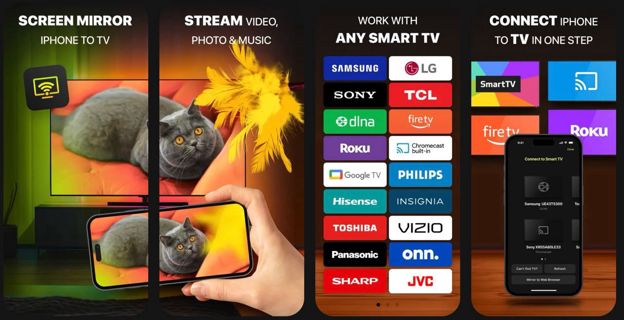
There was a time when showing a photo or video meant crowding around a small screen. Now, with fast, wireless screen mirroring options, iPhone and iPad users can easily share content on the big screen without extra hardware or technical knowledge. Whether it’s a work meeting, a family get-together, or simply enjoying a music video in better sound, mirroring from mobile to TV is now a simple part of daily life.
And it’s not just about convenience — it’s about making moments more immersive, more comfortable, and more connected.
Sharing Isn’t Just Social — It’s Visual
Phones are our digital hubs. We shoot, save, edit, and store everything on them — photos, videos, documents, notes, music. But the screen? It’s limited.
That’s where mirroring steps in. Instead of emailing a photo album to everyone in the room or holding up your phone to show a 30-second clip, you can just mirror your screen or cast specific media in seconds. It’s a small change that makes sharing more natural.
From FaceTime calls with grandparents to slideshow presentations in class or on-the-spot business meetings in a café with a smart TV — wireless mirroring adds value far beyond entertainment.
Why Wireless Wins Over Cables
There’s no shortage of adapters and dongles promising screen sharing. But wireless casting has quietly become the preferred choice — and for good reason:
Zero clutter. No need to fumble with cords or HDMI splitters.
Speed. Setup often takes just one tap.
Portability. If you’re using a Smart TV at a hotel, someone else’s house, or your office, there’s no need to bring anything extra.
Looks better. Most modern screen mirroring apps now support full-resolution visuals, smooth transitions, and clean audio sync.
It works in the background, but the effect is clear: sharing content becomes something anyone can do without “tech stress.”
Everyday Moments That Deserve a Bigger Screen
Screen mirroring is no longer just for gamers or tech-savvy professionals. Here are a few ways it fits right into daily life:
Family gatherings. Share vacation photos, birthday clips, or nostalgic slideshows on the living room TV.
Virtual meetups. Use the TV as a second screen for clearer video calls and easier group chats.
Kids' screen time. Let children watch their favorite videos on a larger screen while keeping your phone free.
Learning or presenting. Whether it's showing a design mockup or explaining a concept to a group, casting your screen keeps everyone on the same page — literally.
And in all these situations, people are leaning toward one-touch wireless casting because it works quietly and quickly in the background.
Compatibility Makes It Work for Everyone
One of the biggest reasons screen mirroring has become more common is how widely supported it is.
Most Smart TVs today — whether they’re from Samsung, LG, Sony, Hisense, or TCL — come with built-in support for screen casting protocols like AirPlay, DLNA, or Chromecast. Even older models or streaming boxes like Roku, Fire TV, or Mi Box support basic screen sharing with iOS devices.
As long as your iPhone or iPad and the TV are on the same Wi-Fi network, the connection is possible — and usually just one tap away.
What’s changed is how smooth that connection has become. Apps now offer:
Adjustable video quality
Low-latency playback (great for videos and music)
Free unlimited photo casting
Session limits clearly explained in free vs paid versions
This means even casual users — not just tech enthusiasts — feel confident using screen mirroring daily.
When Simplicity Meets Purpose
A big part of why screen casting caught on is how purpose-driven apps made it accessible. You don’t need a manual or a setup video. A good app detects your TV, shows your media library, and lets you stream directly.
Take photo casting, for example. Most apps now let you stream high-resolution photos wirelessly and for free, with zero time limits. One option to Cast photos from iPhone to TV even keeps the interface so simple that anyone — kids, guests, older users — can use it without instructions.
And when you want more? Upgrading to full screen mirroring unlocks smoother video playback, longer sessions, and complete control over how content displays.
But the point is: users don’t need to start with everything. They can just tap “photos,” pick an album, and start sharing. That’s what makes the experience sticky.
The Big Picture
Wireless screen mirroring has moved from novelty to utility. It’s now part of the way we live, work, and connect. From home movie nights to impromptu meetings, the ability to mirror an iPhone screen to a TV without cables or stress has made tech feel a little more human.
It’s not about specs or features. It’s about those little moments — the laughter when a funny clip plays on the big screen, the ease of sharing memories without passing your phone around, and the comfort of knowing your content isn’t locked to your pocket.
And that’s why screen mirroring isn’t just popular. It’s practical.
0 comments
Be the first to comment!
This post is waiting for your feedback.
Share your thoughts and join the conversation.
